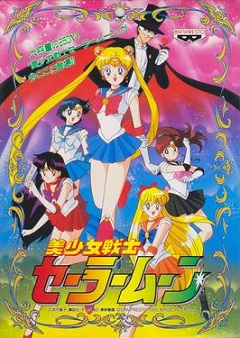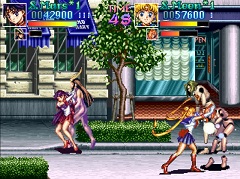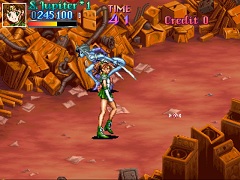 \\
\\Pretty Soldier Sailor Moon
During the early to mid 1990s, beat ‘em ups were everywhere in arcades. They were super popular and for good reason. Friends would meet up and proceed to pummel street thugs, monsters, robots, and the like while scrambling for power-ups all leading up to a showdown with a tough boss. As time passed, the genre got a bunch of licensed tie-ins seeing as how easy it was to drop popular characters from a movie, anime, or whatever into such games, and have them face off against hordes of enemies from their respective license. With that, it was only a matter of time before Sailor Moon threw its hat into the ring. From the not long after the manga started, it quickly became a merchandising juggernaut, with various games coming to the Mega Drive and Super Famicom. Eventually, the anime made its way right into arcades with Gazelle’s 1995 release, Pretty Soldier Sailor Moon.The game is as straightforward as they come. Players simply choose their favorite character from the original Sailor Scout line-up and proceed to march through level after level, pummelling the forces of Queen Beryl and the Kingdom of Darkness. Compared to other beat ‘em ups of the time, Pretty Soldier Sailor Moon is surprisingly bare bones with regard to the number of moves available. It’s mostly punches, jumping kicks, throws, and hardly any special moves. Compared to other beat ‘em ups coming out in the wake of Street Fighter II and trying to innovate, Sailor Moon felt like something out of the late 80s with its move repertoire.
This actually made the game that much harder. Beat ‘em ups have always been challenging, especially in arcades where these games would go out of their way to separate players from their money. Sailor Moon was already doing this in spades with a large number of enemies on the screen, all swarming players. This combined with the Sailor Scouts’ rather short range attacks made it quite difficult to shake off enemies. As a result, players tended to take more damage than they might otherwise have if the game’s move set had been a bit more robust. Playing with a friend definitely helps, but getting to the end of this game is still likely to require feeding in credit after credit.
Where Pretty Soldier Sailor Moon really shines, though, is its presentation. Visually, the game is amazing with beautiful, detailed sprites everywhere. Each character looks like they were lifted straight from the anime, and the backgrounds are full of details. The different stages are from locales one would expect to see in the show, largely taking place in different parts of Tokyo, with little details added to the environments to help bring them to life. Moreover, the color palette used was so bright and vibrant. Icing on the cake for all of this was when players used their special move because the screen would dim and an animation of that character would be front and center as they prepared their attack. These attacks would be really quite grandiose and help to punctuate the high quality visuals of the game.
Musically, the tunes are quite peppy and upbeat for the most part, with melodies one might recognize from the anime as well as other original tracks. However, the instrumentation is very simplified. Various chipsets were still dominating videogame audio during this time, but there were far better ones out there than what was being used for Sailor Moon. Quality-wise, the music is on par with what one might expect from a soundboard that came out five or so years earlier. It’s very bleepy-bloopy with not that many sounds overlapping one another. People who like old Yamaha sound chips may enjoy the tunes, but some will find that it falls short a tad.
It’s worth taking a moment to talk about the game’s developer, Gazelle, as well. This is a studio that only put out two games, this one and a vertical scrolling shoot ‘em up called Air Gallet. What makes the company so special is that it’s arguably the least remembered developer to emerge from the collapse of Toaplan. Anyone who is a fan of old school shoot ‘em ups should instantly recognize that name, as it’s the studio that brought about the likes of Hellfire, Zero Wing, Truxton, Twin Cobra, and a slew of other top notch shmups. When the studio closed its doors, former employees went off to open their own small development companies, almost all focused on making more shoot ‘em ups. These companies would include Takumi, which was responsible for making Mars Matrix and Giga Wing, Raizing, which created a slew of shmups including Battle Garegga, Armor Police Batrider, and the Bloody Roar series, as well as CAVE, arguably the most popular of these spinoff studios, having developed the DonPachi series, Mushihimesama, Death Smiles, Ibara, Espgaluda, and many more. Given the pedigree of these studios, it isn’t really a surprise that Gazelle is largely forgotten. Nevertheless, the studio existed, and Pretty Soldier Sailor Moon was one of the few games that they made.
On the whole, this is definitely a game worth trying out for people who enjoy beat ‘em ups. While there are much better options available gameplay-wise, Pretty Soldier Sailor Moon still looks amazing and is fun to play with friends. It’s also a bit of an interesting historical curiosity that people with a hankering to explore the lesser known quadrants of the genre may want to take for a spin.
- IroIro
October 7, 2019
Genre: Beat 'Em Up
Developer: Gazelle
Publisher: Banpresto
Released: 1995

Japanese Arcade Flyer

Beating up dolls in Tokyo

Sailor Jupitor in the junkyard

The developers even found time to toss in a bit of fan service